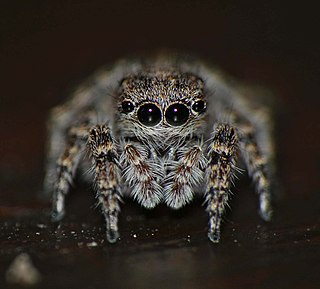Belippo is a genus of ant-mimicking African jumping spiders. The genus was first described by Eugène Louis Simon in 1910.

Evarcha is a genus of spiders in the family Salticidae with 85 species distributed across the world.

Langelurillus is a spider genus of the family Salticidae. All the described species occur only in Africa.
Tanzania is a genus of jumping spiders that was first described by A. Ö. Koçak & M. Kemal in 2008. They are very small spiders, with body lengths ranging from 1.5 to 3 millimetres. Both sexes look alike, but the females are sometimes darker. It is related to the Euophrys and Talavera. Three new species discovered in Tanzania by Wesolowska and Russell-Smith in 2000, and given the genus name "Lilliput" are now included in the genus Tanzania.
Tanzania meridionalis is a species of small jumping spider in the genus Tanzania that lives in South Africa. The male was first described in 2011.
Afraflacilla zuluensis is a jumping spider species in the genus Afraflacilla that lives in South Africa. It was first described in 2013.
Afraflacilla imitator is a jumping spider species in the genus Afraflacilla that lives in South Africa. It was first described in 2013.
Habrocestum auricomum is a jumping spider species in the genus Habrocestum that lives in South Africa. It was first identified in 2013.
Heliophanus bisulcus is a jumping spider species in the genus Heliophanus. It was first described by Wanda Wesołowska in 1986 and is found in Namibia and South Africa. What had been designated the species Heliophanus villosus was recognised as the female of this species in 2003.
Heliophanus ndumoensis is a jumping spider species in the genus Heliophanus that lives in South Africa. It was first identified in 2013.
Heliophanus gramineus is a jumping spider species in the genus Heliophanus that lives in South Africa. It was first identified in 2013.
Evarcha denticulata is a jumping spider species that lives in South Africa and was first identified in 2013.

Asemonea clara is a species of jumping spider in the genus Asemonea that is endemic to South Africa. The spider was first defined in 2013 by Wanda Wesołowska and Charles Haddad. The spider is small, with a cephalothorax that is between 1.9 and 2.2 mm long and an abdomen that is between 2.2 and 2.4 mm long. The white carapace is pear-shaped and the abdomen is white apart from two dark lines across the front, a small round dot in the middle and a black dot towards the back. The male has not been described.
Microbianor furcatus is a jumping spider species of the genus Microbianor that lives in South Africa. The male was first identified in 2013.
Colaxes benjamini is a jumping spider species in the genus Colaxes that was first identified in 2013. It lives in South Africa.
Belippo pulchra is a jumping spider species in the genus Belippo that lives in South Africa. It was first identified in 2013.
Massagris contortuplicata is a jumping spider species in the genus Massagris that lives in South Africa. The female was first identified in 2013.
Dendryphantes limpopo is a jumping spider species in the genus Dendryphantes that lives in South Africa. The female was first described in 2013.
Dendryphantes silvestris is a jumping spider species in the genus Dendryphantes that lives in South Africa. It was first described in 2013.
Rhene timidus is a species of jumping spider in the genus Rhene that lives in South Africa. Only the female has been described, in 2013. The spider is typical of the genus, but larger than Rhene facilis, with a relatively large abdomen measuring 3.5 mm (0.14 in) in length. It has a distinctive epigyne featuring spiralling ridges.


